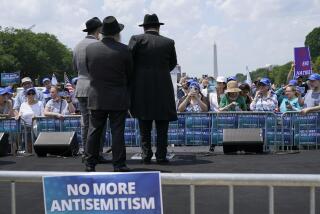Muslim Population Inflated, Studies Find
- Share via
Two new studies have found that Muslims in America may number no more than 2.8 million, less than half the population figure commonly cited by the media and many Islamic organizations.
The studies, coming at a time of intense interest in Muslim Americans following the Sept. 11 terrorist attacks, have reignited the testy debate over whether Islamic organizations are vastly exaggerating their numbers--or whether lower estimates are politically biased by Jewish interests.
One study, an analysis of more than 20 Muslim population estimates, was conducted for the American Jewish Committee by Tom W. Smith of the National Opinion Research Center in Chicago. The survey concluded that Muslim population figures ranged between 1.4 million and 2.8 million.
The other study, a random telephone survey on religious identification of 50,000 households, was conducted by Jewish researchers at City University of New York. That survey found that the Muslim adult population had doubled since 1990, now comprising 1.1 million adults and 650,000 children.
Muslim organizations immediately decried the studies. “It is certainly a desperate attempt to undermine the growing influence and presence of the American Muslim community,” said Hussam Ayloush, executive director of the Council on American-Islamic Relations office in Anaheim. The council, like many other American Muslim groups, uses a population estimate of 7 million. Muslim groups have used this number to claim parity with American Jews. But the CUNY study found that Jews, while declining, number more than twice the Muslim population.
Ilyas Ba-Yunus, a professor of demography at State University of New York at Cortland, said general telephone surveys are certain to undercount Muslims, since immigrants in particular would refuse to respond to them. His own analysis this year yielded a figure of 6.7 million Muslims.
Kenneth Bandler of the Jewish committee denied any bias. He said the committee wanted to glean accurate figures for faith communities it frequently deals with and that Buddhists, Sikhs and other emerging groups would be studied in the coming months. The committee chose to look at Muslims now because of the current intense media focus on them--and the frequent citation of high population figures, Bandler said.
“We’re not seeking to diminish or do battle, and we certainly don’t see the American Muslim community as a threat,” Bandler said. “They are part of the mosaic of American society.”
However, in an article for the Jerusalem Report in May, American Jewish Committee Executive Director David A. Harris urged American Jewry to unite with Israel to battle against the growing Arab and Muslim lobbies here and the challenge they present to long-standing U.S. support for Israel. Harris cited the “myth” of high Muslim population figures as one tactic Muslims are using to advance their position. He was unavailable for an interview Wednesday.
Smith, director of the highly regarded General Social Survey at the National Opinion Research Center of the University of Chicago, reviewed 24 Muslim population estimates published in the last 20 years and said most were based on flawed methodology. For instance, he argued, some surveys, including the one Ba-Yunus used in his analysis, inappropriately assumed that the majority of immigrants from Muslim countries were Muslim. Smith disagreed, saying that, for example, the majority of Lebanese immigrants have historically been Christian. Smith arrived at his numbers by using data from several different surveys, adjusting for such factors as Muslim refusal to respond and adding U.S. government statistics on immigrants, visitors and naturalized citizens.
Egon Mayer, professor of sociology at City University in New York, said his survey data on American religious affiliation were collected by a marketing firm over six months and therefore could not be manipulated. He said the most surprising finding was the doubling in number of Americans who did not choose any religious affiliation.
The demographic brouhaha underscores the difficulty in charting reliable figures for religious affiliation. The U.S. Census does not ask that question, and Brown said religious organizations often misstate their numbers, unintentionally or otherwise.
The Southern Baptist Convention conducted an audit of its membership rolls a few years ago and found 25% of those listed had died or left the faith, Brown said.
In 1999, the National Baptist Convention pledged to accurately count its members after its disgraced president, the Rev. Henry Lyons, was accused of wildly inflating the numbers to hike the sales prices for its mailing list.
More to Read
Sign up for Essential California
The most important California stories and recommendations in your inbox every morning.
You may occasionally receive promotional content from the Los Angeles Times.














